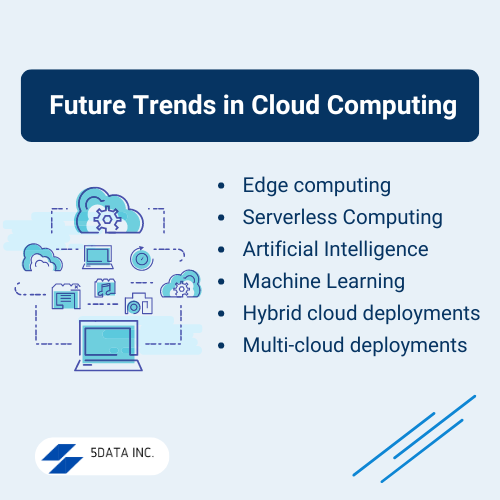Cloud computing is the technology that involves storing and accessing data in cloud environments. These cloud environments are hosted on the internet instead of the computer’s local drive or hard drive. Cloud computing is also internet-based computing, where the resource is provided as a service through the internet to the user.
The rapid evolution of the cloud computing domain has redesigned the processes of storing and processing data and accessing them. This comprehensive overview explores the journey from its beginnings to its present pivotal role in today’s digital age. This article explores the traditional IT structure, evolution in cloud computing, key cloud computing trends, public and private clouds, emerging technologies, cloud-based services, and many more.
Key Takeaways
- Cloud computing has overtaken the traditional IT infrastructure for data management and complex computations.
- Cloud services have an immense impact on the way businesses operate.
- Numerous cloud services have evolved, offering various provisions to meet unique requirements.
- The future of cloud computing holds immense scope.
Traditional Methods and IT Infrastructure
Before the cloud computing era, organizations were heavily dependent on traditional IT infrastructure management to store data. This infrastructure consisted of on-site physical servers, dedicated hardware, databases, operating systems, networking systems, storage systems, and physical data centers. Data centers are physical facilities that offer high availability, optimal operating conditions, and redundancy for IT assets. Traditional on-site infrastructures host all software and hardware within the same physical space. It offers security and control that suits companies with strict regulatory compliance needs. Despite serving the purpose, it introduced certain limitations like high-cost maintenance, scalability constraints, and limited access.Emergence of Cloud Technologies
Cloud computing emerged in the mid-20th century and is rooted in visionary ideas. Pioneers and researchers have visualized a world where computing resources can be shared and accessed remotely. The early stages of cloud computing revolved around utility computing, grid computing, and the basics of distributed cloud computing. The emergence of cloud computing trends and services has marked a paradigm shift in the world of artificial intelligence (AI). Organizations like Amazon Web Services (AWS) and others have introduced cloud platforms that offer computing resources. Cloud services promote data centers by offering virtualized online computing resources for on-demand flexibility and scalability. By associating with each other, they support the continuity of business, disaster recovery, and the allocation of IT resources that help companies effectively meet their computing needs and adapt to ever-changing demands. An efficient software application development company looks forward to adopting the latest technologies in the cloud computing industry.Cloud Infrastructure Management
Cloud infrastructure is an association of hardware and software components that establish the cloud. Cloud providers maintain data centers across the globe with thousands of IT infrastructure components like networking equipment, physical servers, and storage devices and configure these devices using all types of operating system configurations. Let us look into the components and the architecture of the cloud.Front end(Fat client, Thin client)
The user interface of cloud computing has two sections of clients, namely thin clients and fat clients. Thin clients utilize web browsers with lightweight and portable accessibilities. Fat clients use diverse functionalities to provide a strong user experience.Backend Platforms
The core cloud computing is made of backend platforms with many servers for storage and processing. Management of application logic is handled through servers, and storage offers productive data handling. The association of these platforms offers high processing power and the ability to manage and store data behind the cloud.Cloud-based Delivery and Network
The intranet, internet, and intercloud give on-demand access to the computer and computing resources. The internet offers global accessibility, while the intranet helps in the internal communications of the services within the organizations, and the intercloud enables interoperability across different cloud services.Delivery Models in Cloud Architecture
Cloud architecture refers to the utilization of distributed cloud computing resources for running web applications. It allows organizations to pursue their cloud strategies with different cloud infrastructure delivery models. Let us dive into diverse delivery models in the cloud ecosystem.Infrastructure as a Service
Infrastructure as a service offers organizations an entire spectrum of cloud computing infrastructure as a pay-and-use service, which includes data storage, operating systems, networking tools, cloud servers, and servers owned by external cloud providers.Software as a Service
Software as a service is one of the renowned cloud services that provides software access to users from their browsers. Developers design web applications, deploy them on cloud platforms, and allow users to subscribe to the app and charge a fee. Because developers completely manage software as a service, users don’t need to update or troubleshoot the application when they encounter issues.Platform as a Service
Platform as a service is one of the most used cloud computing models that offer developers the resources required to build, test, and deploy applications. Developers utilize this cloud service for seamless integration rather than opting for containerization, databases, software development frameworks, and other software requirements. Cloud platforms and the latest technologies of the cloud ecosystem play a crucial role in better application development services.Adoption models in Cloud Infrastructure
Organizations go for cloud adoption to extend their software use cases beyond traditional or basic computing environments. They opt for different cloud infrastructure options to meet their operational requirements. Let us look into the adoption models in cloud environments.Hybrid Cloud
A hybrid cloud model enables organizations to use both public and private clouds simultaneously. A public cloud can be used to access and share resources across various geographical locations. Meanwhile, private clouds provide a self-managed environment for storing sensitive data in isolated environments.Public Cloud
The public cloud enables organizations to access the cloud computing landscape and capabilities in a multi-tenant environment. Rather than owning the underlying infrastructure, you are allowed to rent cloud environments from third-party cloud providers.Private Clouds
Private clouds are the physical infrastructures owned and maintained by a single organization. Organizations arrange on-premise cloud environments in their data centers. Underlying physical resources are not shared, unlike how they can be shared in public cloud computing environments. Organizations are responsible for providing, managing, and maintaining all the software and hardware components of private cloud computing architecture.Challenges and Cloud Security Concerns
Let us look into the evolving threat landscape in the cloud computing domain.Privacy and Data Security
Protection of the sensitive data stored in the cloud is a paramount challenge. Data breaches, cyber-attacks, and unauthorized access impose severe risks. Access controls, adequate encryption, and data segregation measures are important to mitigate these risks.Vendor Lock-in
As organizations adopt cloud environments, they depend on particular cloud provider’s services and technologies. Vendor lock-in hinders flexibility and makes it difficult to switch cloud providers or opt for multiple cloud providers and multi-cloud strategies.Compliance and Legal Issues
Different geographical locations consist of varying regulatory requirements for data storage and handling. Compliance challenges occur when cloud providers operate across borders, conflicting with local regulations. Management of compliance, along with data protection laws like HIPAA and GDPR, is a continuous concern.Insider Threats
Accidental or intentional insider threats have a direct impact on cloud security. Employees with access to cloud resources might unintentionally leak or expose the data and misuse the access. Constant monitoring and identity management steps are necessary for mitigating insider risks while maintaining efficiency.
Future Trends in Cloud computing
Cloud computing unfolds immeasurable depths of exploration and advancements. Let us dive into the latest trends that have emerged, such as edge computing, serverless computing, hybrid cloud solutions, machine learning, and other innovations that have changed the dynamics of cloud technology and introduced a whole new era in the world of artificial intelligence.Edge Computing
Edge computing inculcates data processing, data storage, and data analysis, which is performed geographically near the source. In edge computing, data storage, and computation are associated and brought closer to the source devices and sensors. This cloud technology offers enhanced efficiency, reduced latency, strong privacy and security, and an increased rate of data transmission.Serverless Computing
Serverless computing is one of the most emerging technologies in cloud computing. This cloud technology backend services on a per-user basis. Serverless computing allows the developers not to maintain servers during the execution of code. The code execution is managed and maintained by the cloud provider. The Cloud users must pay in an as-per-you-go format, which means the users will only pay when their code execution is successful.Artificial Intelligence and Machine Learning
One of the most emerging trends in cloud computing is machine learning, as it is a cost-effective technology that requires high computational power for data collection and training. Many cloud service providers like Google Cloud, IBM, Amazon, and Microsoft Azure are adopting machine learning.Hybrid and Multi-cloud Deployments
The demand for hybrid and multi-cloud solutions is increasing. Many insurance companies, banks, etc., go for hybrid cloud solutions that provide a combination of private and public cloud computing services to store their data. Adopting multi-cloud strategies reduces the potential risks and failure points and improves efficiency. Multi-cloud allows you to choose a specific service from a particular cloud service provider that aligns and meets your requirements rather than deploying your entire application on that cloud. The best software application development company adopts the latest and diverse technologies of cloud computing to improve their efficiency.Conclusion
So far, we have discussed traditional IT infrastructure, the emergence of cloud technologies, cloud-based AI services such as edge computing, hybrid and multi-cloud, machine learning, serverless computing, etc. These services enhance and optimize the performance of your application. Cloud migration is a great idea if you are looking to code, test, and deploy large size of applications for your software development. Cloud computing continues to emerge with the latest features and updates to existing services.Frequently Asked Questions(FAQs)
1. What is cloud management? Cloud management refers to the administration of cloud services and resources to ensure optimal performance, security, and cost efficiency. 2. How has the cloud evolved over the years? Cloud management has evolved from basic infrastructure management to sophisticated automation and orchestration. It initially focused on managing virtual machines but now includes orchestration and multi-cloud environments with advanced data processing and analysis. 3. What are the primary trends shaping the future of cloud management? Key trends include: Multi-cloud environments and hybrid cloud solutions – Organizations are leveraging multiple cloud providers and on-premises infrastructures, needing unified management solutions. Containerization and serverless computing – Managing microservices-based architectures is becoming crucial. Security and Compliance – With increased adoption, ensuring robust security and compliance measures across clouds is imperative. 4. How does ‘cloud management’ impact ‘business operations’? Effective cloud management improves agility, scalability, and resource optimization, changing the way businesses operate and leading to improved business outcomes. It enables faster time-to-time market, cost savings, and better alignment with business goals by optimizing IT solutions.
About the Author...
Amulya Sukrutha is a passionate computer science engineer specializing in the Data science field. She also describes herself as an enthusiastic strength and endurance trainee. She played professional tennis during her early years and found her path in Software development and machine learning later. She is also passionate about creating content and learning about new technologies.
